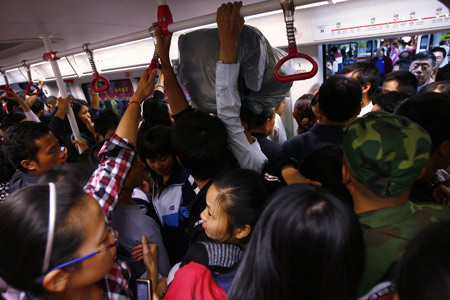Subway in some cities not practical: critics
Jiang Qian, 46, of Tianjian, recalled she was anxious about using the city's first subway line long before a train pulled into the station in 2005. She used the subway every day for a while, but then it became more of a burden for her, so she decided to switch back to buses.
 |
|
On the first day of free subway service on November 1 in Guangzhou, Guangdong Province, thousands crowded a train. Experts said poor planning in some cities have lead to poor utilization of trains. |
"I had to wait 20 minutes for the train," said Jiang, an accountant. "The nearest metro station near the shopping center I usually visit is about a 15-minute walk from the station."
Various cities in China are busy building new metro lines, a symbol of a modern metropolis. Some see new public transportation options as a good way to alleviate traffic jams when millions are using cars to get to the supermarket and shopping malls.
However, despite the need for more subway lines and better public transportation, some experts and public transportation users in many cities feel planners need to study where they put new subway stations and lines to ensure the maximum usage.
Wu Lisha, 28, a local resident in Foshan, Guangdong Province, was thrilled about the new line that went into service earlier this month.
"The metro is a very new transportation for our local people who have lived in this city for a long time," she said. "However, the fare is more expensive than the bus."
Wu has to pay 5 yuan ($0.74) for each subway ride, and just 40 yuan ($5.9) for an entire month of bus rides.
More or less
Dong Liming, a professor of urban and regional planning at Peking University, told the Global Times that subways are an effective way of tackling traffic jams on the road. But some mid- or small-sized cities have to consider whether a new subway is actually needed. "Indeed, some cities do not have the heavy traffic load necessary to build a metro," Dong said.
Dong said local governments should do advance planning to tackle traffic problems. "A line that would benefit the majority of people should be the main purpose of having a metro," Dong said. "Ineffective connections are the major problem that most metros are facing."
In 2006, there were only 10 metro lines in the country. Just last year, the number of metro lines nearly quadrupled to 37 and it is expected to jump to 86 by 2015.
In Tianjin, a second metro line is expected next year, followed by a third in 2012. In Beijing, there should be 1,000 kilometers of subway tracks by 2020.
"The development of subway transportation is rapid. We have accomplished what developed countries have done in a decade," Beijing vice mayor Huang Wei told report-ers earlier.
Building more metro lines does not necessarily lead to fewer traffic jams or to the level of usage that urban planners desire. Some metro lines have failed to attract enough passengers and their full capacity has not been realized.
 0
0 






